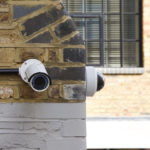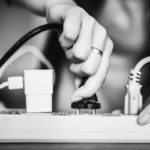Troubleshooting Infrared Security Cameras
If you’re looking for surveillance around-the-clock, infrared night vision cameras are a smart choice. These security cameras enable you to monitor your business or property overnight, when light sources are minimal. Night vision cameras have infrared (IR) LEDs which emit their own source of light, but of course, nothing is perfect. When using infrared cameras, you may come across some of these common IR issues.
Foam Ring
Keep in mind that not every camera will have one, but most of them do. The foam ring helps to eliminate the reflection of the IR light on the glass. When the IR light reflects off the glass and back into the lens, it will wash out your footage, essentially rendering your camera useless. If your camera seems to be missing a foam ring, first make sure that your camera should in fact have one. If so, to eliminate the issue, replace the foam ring.
While the aforementioned situation is rather unlikely, having an improperly placed foam ring is far more common. If the foam ring is not flush with the IR board, or the base of the lens, it will produce a similar effect as a missing foam ring. To correct this, you will need to open your camera and reposition the foam ring accordingly.
Glass
Most security cameras come with a thin plastic protective film over the glass on the camera. It is in place to protect the camera, however, it should not be left on when the camera is in use. Once your camera is installed and you are satisfied with the placement and viewing angle, remember to remove and discard the film covering.
Another common issue with the glass is obstructions. Dirt, dust, and fingerprints on the glass can create infrared glare which interferes with the quality of your footage. Be sure to clean the glass routinely to ensure that your cameras are obstruction-free.
Infrared Glare
As mentioned, debris on the camera or glass reflection can cause IR glare, but there are other common causes. With outdoor cameras, you want to avoid aiming your camera at reflective services (ex. bodies of water, large lightly colored surfaces). For indoor cameras, be wary of the items or furniture around your camera as they may be close enough to reflect the IR LEDs. Despite all this, the most common cause of IR glare is improper installation. Cameras should be carefully mounted and tested in both day and low light conditions before the job is completed.
Infrared Reflection
Here are some of the common things that cause IR reflection:
- Your camera is indoors looking through a window. Because the IR will bounce off the window, IR cameras should not be mounted behind any glass.
- For cameras with a glass dome cover, be sure that all the IR LEDs are looking through the glass dome. If your camera is set improperly inside the glass cover, the IR light will bounce inside the camera and hit the image sensor.
- Remember to remove the plastic cover on the outside of the glass dome
Clean the glass dome with a damp microfiber cloth or windshield cleaner only. - If your camera is mounted too close to a wall, ceiling, or between two walls, the IR LEDs will be obstructed and will result in IR reflection.
Infrared Obstruction
As mentioned, when an object is too close to your IR camera, IR light will cause overexposure. In turn, to compensate, your camera will automatically dim the picture, reducing the IR intensity of your camera. Again, proper placement, installation, and testing will minimize these issues.
Share your own troubleshooting tips with us and your peers on Facebook, Twitter, LinkedIn, and Pinterest.
Find a great selection of cost-effective infrared night vision cameras, CCTV surveillance packages and much more at SecurityCamExpert.com. Call 888-203-6294 to learn more about our products and services or to request a free quote!
Troubleshooting Tips For IP Security Cameras
After investing your time and money into choosing the best security cameras to suit your needs, it can be frustrating to come across issues with them not working properly. When your security system is down, not only is it a nuisance, but it can leave your property vulnerable.
Before giving up on your security cameras and shopping for new ones, review these troubleshooting tips for common security camera issues.
- Connection & Power
Though it may seem like common sense, sometimes we overlook the obvious. If your security camera is not working, check all of the connections. Make sure that the camera is correctly connected to the power source as well as any other devices.For wireless security cameras – Check the Wi-Fi connection (if the wireless security camera is connected successfully via Wi-Fi). You can use a network cable to test the network connection. Ensure your router is working properly and, of course, check the power supply.For wired or PoE security cameras – Make sure video signal and power supply is well transmitted. For a PoE security camera, check the PoE injector or PoE switch is in order, compatible and working. If you have an NVR security system, double check that all the connections to the system are correct and secure.
- Cabling
A majority of connection issues center around cabling problems. For example, if the IR LEDs do not turn on at night in the dark, it is likely a cable problem and no images or video recordings will come out.To check this, use another cable to connect the camera to see if the problem is solved. For a PoE security camera, you use a Cat 6 or Cat 5 Ethernet cable.
- Settings
It is easy to forget about camera settings. You may find that your security camera doesn’t do 24/7 recording, no motion detection alerts, can’t connect to Wi-Fi, or can’t record video at night all because you did not set up the settings. Remember: Security cameras do have features, some of which have been enabled by default and some that need manual enabling on your end.There is usually computer software or an app for a mobile device that is in place so you can easily control and manage your system, such as adjusting the settings accordingly.
- Reboot
The “Golden Rule” in IT troubleshooting is to reboot the device. When you reboot a security camera, it flushes the cache, recalibrates the settings, and revises the connections. To reboot you camera, directly unplug the power supply, wait for a few seconds, and plug it in again. - IP Address
Each IP security camera needs to have a unique IP address so it can send and receive data via the Internet or a computer network. If there is another device using the same IP address with the camera, there will be a conflict and your security camera will not work. If you are experiencing issues, check the IP addresses to resolve any conflicts.There are two ways to check:
- On a computer that is connected to your cameras, go to the Windows search box and type “cmd” to open the DOS command prompt. You can type the command “arp -a” to see if there are any IP conflicts.
- You may type the command “ping cameraIPaddress -t” (ex. for IP address 192.168.0.999, type “ping 192.168.0.999 -t“). If you received results with “Unreachable” or “Timed Out” it means the IP security camera is not connecting to the network. You should change the camera’s IP address or assign a new one.
- Update Firmware & Software
Most manufacturers regularly release firmware updates to fix security camera issues and glitches, and also to add new features. Make it a habit to regularly check the brand’s official website to see if new firmware has been released for your camera and update accordingly. Remember to make sure the firmware you download is the correct version for your security camera.If you can’t connect to the security camera via software, it’s likely due to incompatibility of the software and firmware. If you are updating your firmware, be sure to check for updates for your software as well.Remember, it is best to use the software or app from the manufacturer since it is designed to work with all the features of your security camera without compatibility issues. While third-party software exists, it may or may not be fully compatible with your cameras.
- Reset To Factory Default
This is often one of the last ditch efforts to resolve an issue. Factory reset means all settings and configurations will be removed and will go back to the “factory default” settings (you will need to enable features and other configurations again).Some security cameras come with a reset button, while others may come with a pinhole as the reset function, requiring a needle to enable factory default.
- Manufacturer FAQs
Most of you problems or questions can be answered by checking the FAQ section of your manufacturer’s website. Search keywords about your problem and you should get related troubleshooting methods. - Tech Support
If the FAQ section did not help, you may want to reach out to the company from which you purchased your equipment. Most companies offer tech support and you can reach out via email or phone call. Remember to provide as much details as possible and a professional technician should be able to help you fix the problem or offer alternative options accordingly.
If you need help choosing the right security cameras for your property, as well as installation services, feel free to contact us! You may browse our selection online at SecurityCamExpert.com or call 888-203-6294 to schedule a site survey or get a free quote. You can also find us on Facebook, Google+, Twitter, LinkedIn, and Pinterest.

